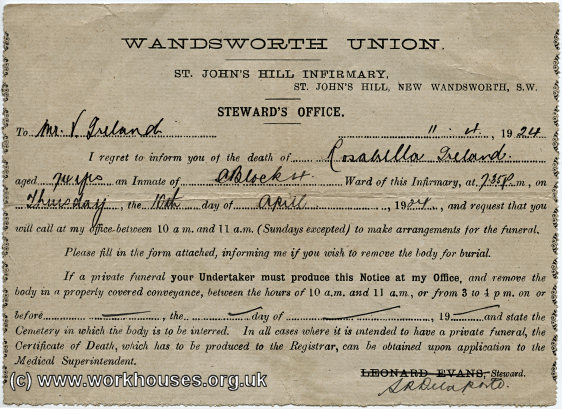Workhouse Deaths and Burials
Parish Records
The parish and other workhouses that operated prior to the 1834 Poor Law Amendment Act had no systematic procedures for recording events such as births or deaths that took place within their walls. In cases where such registers existed, their survival is very rare. Prior to the introduction of the national civil registration system in England and Wales in 1837, therefore, the primary source of information about the life events of poor people are church records. These include not only those of the Church of England but also of the Roman Catholic Church, and also non-conformist churches such as the Methodists.
Burial registers typically do not include a date of death, but in the vast majority of cases, this will have taken place within the previous few days.
The majority of Church of England parish registers, and many non-conformist registers, are now held in the relevant county and borough record office. A good starting point for locating these is the National Archives' Discovery system.
An increasing number of church/parish records, including burial records, are now online, for example:
- Ancestry
— good on London records
- The Genealogist — good on Catholic/non-conformist records
- The Society of Genealogists
- The FreeREG Project
- BMDRegisters
- UKBMD — Local indexes for England and Wales
- Online Parish Clerks
- Scotland's People
- Roots Ireland — for Irish Ancestors
Many parish registers have been transcribed by family history societies and published in various formats such as booklet or CD — many of these are available from sources such as S&N Genealogy Supplies and the FFHS GENfair online store.
Civil Registration and Poor Law Union Records
The new national civil registration system, which came into operation on 1st June 1837, divided England and Wales into 27 numbered regions. These were each then subdivided into registration districts under the control of Superintendent Registrars. In 1851, there were 623 registration districts which, for the most part, coincided with the boundaries of poor law unions. Register offices in many unions were located adjacent to union workhouses.
It was the duty of the workhouse master to register all deaths within the workhouse within five days of their taking place. The master also kept his own register of deaths. Other workhouse registers such as the creed register, the admission/discharge register, and medical relief book would also record inmate deaths.
From the 1880s, it became increasingly common for poor, but not destitute, persons to enter the workhouse purely for medical treatment in its infirmary. If such an individual died, their death would be recorded as being in the workhouse infirmary, although their family might well be living outside the workhouse.
If an inmate died in the workhouse, the death was notified to their family who could, if they wished, organize a funeral themselves. If this did not happen, the Guardians arranged a burial in a local cemetery or burial ground — this was originally in the parish where the workhouse stood, but later rules allowed it to be the deceased's own parish. A few workhouses had their own burial ground on or adjacent to the workhouse site. The burial would be in the cheapest possible coffin and in an unmarked grave, into which several coffins might be placed on the same occasion. Under the terms of the 1832 Anatomy Act, bodies unclaimed for forty-eight hours could also be disposed of by donating them for use in medical research and training — this was not specific to workhouses, but applied to any institution whose inmates died while in its care. Depending on the site, such burials might feature in the relevant parish or cemetery records.

Wandsworth Union death notice, 1924.
© Peter Higginbotham.
In 1904, in an attempt to remove the stigma of having been born in a workhouse, the Registrar General recommended that the registration of such events should not identify their location as being a workhouse. In 1918, this procedure was extended to workhouse deaths. Many of these addresses are listed on the separate addresses page. In 1921, Scotland followed a similar course and recorded what were referred to as 'substitute' addresses for births and deaths taking place in a poorhouse.
In summary, then, from 1837 onwards there are three potential sources of information about a workhouse death:
- A civil registration record of the death
- A workhouse record of the death, and possibly also the burial
- A possible parish or cemetery record of the burial
Civil registration records are not themselves publicly viewable, only the indexes to them. Each index entry gives the person's name, the registration district, and the three-month quarter in which the event took place. Too see the full details, copies of the death certificate must purchased from, either from the local register office concerned, or from the relevant General Register Office:
Websites holding civil registration death indexes include:
- FreeBMD (free but incomplete)
- UKBMD (links to local register offices that have online index searching)
-
Ancestry UK
- Find My Past
- Genes Reunited
- The Genealogist
Some websites which provide online versions of the death indexes also provide an online certificate ordering service.
Websites holding at least some post-1834 union workhouse death and burial registers include:
-
Ancestry UK
— strong on London workhouses
- Find My Past — Westminster, Liverpool, Cheshire and Manchester workhouses
- Deceased Online — Includes cemetery records from many local authorities
- FamilySearch — Cheshire and Norfolk workhouses
Some workhouse death and burial registers have been transcribed by family history societies and published in various formats such as booklet or CD — many of these are available from sources such as S&N Genealogy Supplies and the FFHS GENfair online store.
From the mid-1850s, many London workhouses, hospitals and prisons buried their unclaimed dead at the London Necropolis at Brookwood in Surrey
.Unless otherwise indicated, this page () is copyright Peter Higginbotham. Contents may not be reproduced without permission.



